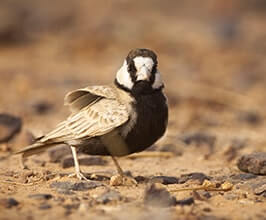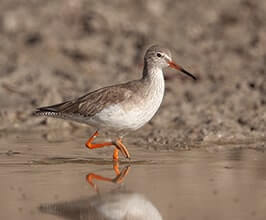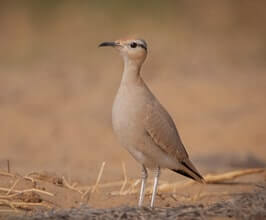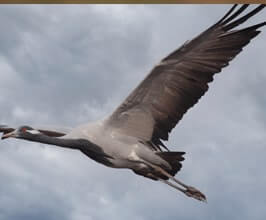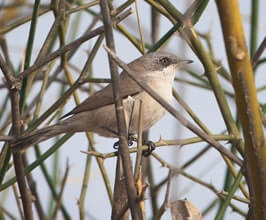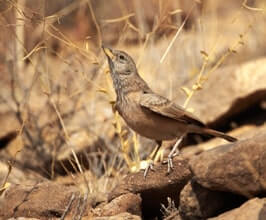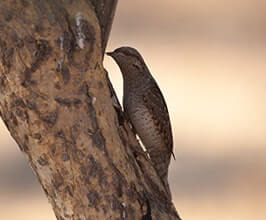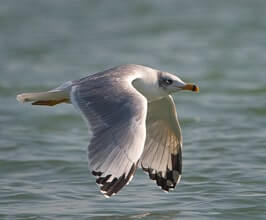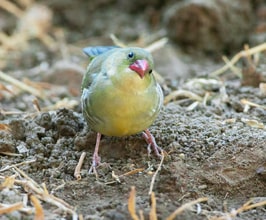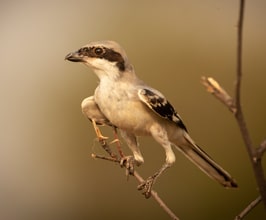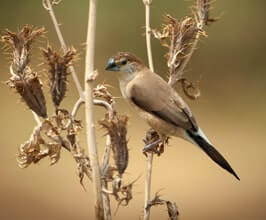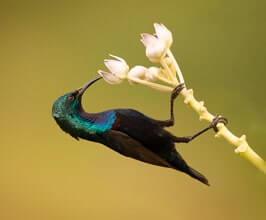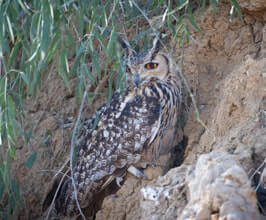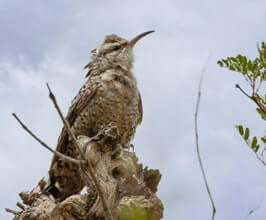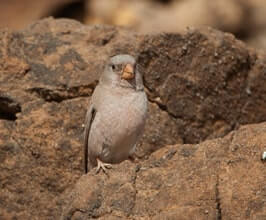Delhi – Ranthambore National Park - Bharatpur - Keoladeo National Park - Dholpur - Agra - Corbett National Park - Kumeria - Pangot - Sat Tal
15 Days / 14 Nights
Our North India Birding Tour is perfect for those who want a birdwatching holiday packed with hundreds of bird sightings, wildlife adventure, and cultural experience of India. Besides showcasing the birds of North India, More Info
Booked as per
request.
Included except arrival and departure city.

Private guide for complete tour.
Airport to Airport.
2-8PAX
Included
Our North India Birding Tour is perfect for those who want a birdwatching holiday packed with hundreds of bird sightings, wildlife adventure, and cultural experience of India.
Besides showcasing the birds of North India, our tour takes you on wildlife safaris in search of the tiger, and also includes a sightseeing tour of the Taj Mahal, one of the seven modern wonders of the world. These recreational outings are add-ons that don’t take away any thrill or substance from the birdwatching adventure of India.
Our North India birding trip focusses on two states: Rajasthan in the west of India, and Uttarakhand in the lap of the Himalayas.
We first cover Rajasthan and target its three prime birding and wildlife hotspots: Ranthambore National Park, Keoladeo National Park and National Chambal Sanctuary. Ranthambore is one of the largest national parks of India and quite popular for Bengal Tigers. Keoladeo is a proper bird sanctuary that hosts about 400 bird species. Chambal is home to 250 species of resident and migratory birds.
Over the first week, we cover these three birding destinations of Rajasthan. The birds we look out for include Indian Pitta, Shikra, Painted Spurfowl, Painted Sand-grouse, White-rumped Flameback, Indian Golden Oriole, Great Tit, Crested Bunting, Common Tailor Bird, Paradise Flycatcher, Black Francolin, Painted Francolin, Grey Francolin, Common Quail, Rain Quail, Blue-breasted Quail, Jungle Bush Quail, Rock Bush Quail, Painted Spurfowl, Indian Peafowl, Lesser Whistling Duck, Greylag Goose, Bar-headed Goose, Ruddy Shelduck, Common Shelduck, Comb Duck, Cotton Pygmy Goose, Gadwall, Eurasian Wigeon, Mallard, Spot-billed Duck, Common Teal, Garganey, Indian Courser, Great Thick-knee, Red-crested Pochard, Ferruginous Pochard, Sarus Crane, Imperial Eagle, White-tailed Eagle, Greater Spotted Eagle, Indian Spotted Eagle, Dusky Eagle-Owl, Pallas's Fish Eagle, Pallid Harrier, Darters, and several types of nightjars, pelicans, storks and terns.
Halfway into our North India birdwatching expedition, we take a break from birding for a trip to India’s biggest tourist attraction, the Taj Mahal and Agra Fort, before moving on to the Himalayan state of Uttarakhand in the north of India.
We focus particularly on birding at Jim Corbett National Park and the forests of Kumeria nearby. Corbett is the oldest national park of India and thrives with immense wildlife and avifauna. It is home to 500 species of birds and our targets here are Kalij Pheasant, Great Hornbill, Tawny Fish Owl, Ibisbill, Common Iora, Great Hornbill, Himalayan Vulture, Cinereous Vulture, Peregrine Falcon, Bar-winged Flycatcher-shrike, Crested Tree Swift, Black-hooded Oriole, Collared Falconet, Wallcreeper, Nepal Wren Babbler, Brown Dipper, Common Green Magpie, Black-chinned Babbler, Black-crested Bulbul, Crested Fisher, Yellow-bellied Fantail, Tawny Fish Owl, Brown Fish Owl, Velvet-fronted Nuthatch, Green-backed Tit, Himalayan Bulbul, Great Tit, Rufous Woodpecker, and Lesser Yellownape Woodpecker.
These birding expeditions at Corbett coincide with the morning and afternoon wildlife safaris we do in search of the tiger. With luck, we shall spot one.
In the last leg of our North India birdwatching trip, we scour the birding trails at Pangot, the Pheasant capital of India, for Cheer Pheasant, Koklass Pheasant, Hill Partridge, Kalij Pheasant and many other birds before a final birding stint at Sat Tal, a group of seven interconnected lakes in the lower Himalayas.
The entire birding tour of North India lasts 15 days, almost every one of which is either a full birding day or a half one. INDIA BIRDING TOURS has, over the years, set new precedents and reached new milestones in quality birdwatching and wildlife tourism in India. The birding trails of North India we’ve singled out yield maximum sightings to make your India birding holiday worthwhile.
Lodging: For the most part of our North India Birding Trip, you get to stay at resorts or hotels that are close to or within the national parks and wildlife sanctuaries. At Pangot, we put you up at a lodge for two nights. All accommodations offer top-class service, comfortable bedding, meals, and basic amenities. These lodgings have been chosen exclusively to add to your birding adventure of India. We particularly select the hotels and resorts that are closest to birding locations.
Meals: Birdwatching can metaphorically be food and wine for many a birder, but the matters of the belly are, by no means, trivial for us. We ensure that you have the choice of both Indian and Western meals on the table, including your preference for vegetarian or meat-based food. Meal options may be a bit limited at the lodge in Pangot or at resorts that are far from urban centres, but the taste, quality and hygiene standards are never compromised.
Tour Difficulty: The Rajasthan leg of our North India birding holiday is quite easy. Having said that, a day of birding entails long walks in forests, grasslands, or along marshes. You should be able to put in the required legwork while carrying your birding equipment such as binoculars, camera, field guide and backpack. Birding in Uttarakhand, is comparatively difficult, owing to the mountainous landscape. But we take care to avoid steep climbs or long uphill slogs so that you reserve your energy for where it needs to be put: birdwatching.
Tour Extension: Though our tour includes the visit to the Taj Mahal and Agra Fort to gladden the tourist in you, there is still plenty of recreational fun to be had alongside our birdwatching tour of North India. You may want to do sightseeing tours of the Rajasthani cities of Jaipur or a short spiritual jaunt of Varanasi and temples of Khajuraho. In Uttarakhand, you may want to check out the city of Nainital, a great draw among tourists. Whatever the tour extension you want, just let us know several days in advance and we will make the necessary arrangements.
Climate: Our North India Birding Tour is best done in the winter and spring seasons lasting from October to mid-May. The winters in Uttarakhand are quite cold, so you must carry winter clothes along. The spring is pleasant, but the mornings and evenings may be cold. The same goes for Rajasthan, though it is relatively warmer than Uttarakhand. The days of spring months in Rajasthan can be a bit hot, so summer wear will do on those occasions. You must also carry a raincoat for an odd shower.
India’s capital Delhi is where our North India birding adventure begins. Our representative receives you at the airport or railway station in Delhi and drives you to a pre-booked hotel. After a short rest break, we take you out for a birding tour of Delhi.
A metropolis like Delhi may not come across as a birding destination at first glance, but the Okhla Bird Sanctuary, located at Okhla barrage on the outskirts of the city, quickly puts paid to such notions. As many as 300 bird species have been spotted here and our targets for the day include two endemic species, Striated Babbler and White-tailed Stonechat, besides several other birds such as Eurasian Collared-Dove, Laughing Dove, Yellow-footed Green-Pigeon, Greater Coucal, Asian Koel, Grey-headed Swamphen, White-breasted Waterhen, Black-winged Stilt, Red-wattled Lapwing, Pheasant-tailed Jacana, Temminck's Stint, Wood Sandpiper, Whiskered Tern, Oriental Darter, Great Cormorant, Indian Cormorant, Grey Heron, Cattle Egret, Indian Pond-Heron, Black-headed Ibis, Black Kite, Spotted Owlet, Indian Grey Hornbill, Common Kingfisher, Green Bee-eater, Brown-headed Barbet, Rose-ringed Parakeet, Black Drongo, Long-tailed Shrike, Ashy Prinia, Plain Prinia, Sykes's Warbler, Clamorous Reed Warbler, Plain Martin, Red-whiskered Bulbul, Indian White-eye, Rosy Starling, Bank Myna, India Robin, Oriental Magpie-Robin, Bluethroat, Pied Bushchat, Citrine Wagtail, Paddyfield Pipit, and Red-headed Bunting.
In the evening we return to our hotel for dinner and overnight. We sleep early because we have an early start the day after.
After an early breakfast, we transfer you to New Delhi Railway Station for a 5-hour train journey to Sawai Madhopur in Rajasthan. Thereon, a short cab ride takes us from the Sawai Madhopur station to our destination for the day, Ranthambore National Park.
Spread out over an area of 1334 square km, Ranthambore National Park is one of the largest wildlife sanctuaries in India. The Bengal Tiger is its chief attraction, but thousands of tourists are drawn to this biodiversity hotspot to see other wildlife, such as Indian leopard, striped hyena, nilgai, wild boar, sambar, chital, rhesus macaque, and mugger crocodile. The park is also one of the best birding destinations of North India.
Upon our arrival, we check into a resort and then set out on an afternoon safari at Ranthambore National Park. On Day 3(the following day), we do two wildlife safaris, one in the morning and another in the afternoon. Hundreds of bird species can be spotted at the park, but our birding expedition of Ranthambore focusses particularly on Indian Pitta, Shikra, Painted Spurfowl, Painted Sand-grouse, White-rumped Flameback, Indian Golden Oriole, Great Tit, Crested Bunting, Common Tailor Bird, Paradise Flycatcher, Rose-ringed Parakeet, Painted Stork, Lesser Whistling Duck, Little Cormorant, White-breasted Waterhen, apart from several others. Dinner and overnight at Ranthambore resort.
The areas around Ranthambore National Park have a great deal of birding potential. There is Padam Talao, the largest of the many lakes in the park where one may see a lot of aquatic birds. There are grasslands, meadows, and lush woods that host several interesting bird species of North India. There are villages close by that, apart from a birding session, also make for a culture trip of rural Rajasthan.
After breakfast at the resort, we set out to scour these areas and look for birds like Black Francolin, Painted Francolin, Grey Francolin, Common Quail, Rain Quail, Blue-breasted Quail, Jungle Bush Quail, Rock Bush Quail, Painted Spurfowl, Indian Peafowl, Lesser Whistling Duck, Greylag Goose, Bar-headed Goose, Ruddy Shelduck, Common Shelduck, Comb Duck, Cotton Pygmy Goose, Gadwall, Eurasian Wigeon, Mallard, Spot-billed Duck, Common Teal, Garganey, Northern Pintail, Northern Shoveller, Red-crested Pochard, Common Pochard, Ferruginous Pochard, Tufted Duck, Small Button Quail, Yellow-legged Buttonquails, Barred Buttonquails, Eurasian Wryneck, Brown-capped Pygmy Woodpecker, Yellow-crowned Woodpecker, Black-rumped Flameback, White-naped Woodpecker, Brown-headed Barbet, Coppersmith Barbet, Indian Courser, etc.
After a busy day of birding at Ranthambore, we retire to our resort for dinner and overnight.
We hit the northward road from Ranthambore to Bharatpur right after breakfast. A four-hour journey on a metalled road cutting through rural Rajasthan takes us to Bharatpur, which is home to Keoladeo National Park, previously known as Bharatpur Bird Sanctuary.
Keoladeo is often hailed as one of the best birding hotspots in the world. An acknowledged World Heritage Site, Keoladeo National Park hosts about 400 bird species, including several wintering migratory birds, especially waterfowls. The park’s geography comprising of dry grasslands, wetlands, swamps and scrubs make it a thriving avian habitat. Every year, thousands of birders and ornithologists visit Keoladeo to see and photograph hundreds of birds. A good day of birding at Keoladeo National Park can yield up to 150 bird species, if not more. The prized sightings include Indian Courser, Sociable Lapwing, Imperial Eagle, White-tailed Eagle, Greater Spotted Eagle, Indian Spotted Eagle, Dusky Eagle-Owl, Darters, Large-tailed Nightjar, Indian Nightjar, Grey Nightjar, Sarus Crane, Demoiselle Crane, Black-necked Stork, Painted Stork, Asian Openbill Storks, Common Pelican, Dalmatian Pelican, Black Bittern, Greater Painted Snipe, Marshall's Iora, Brook's Leaf Warbler and Siberian Rubythroat.
Upon our arrival in Bharatpur, we check into a resort and go birdwatching at Keoladeo National Park. We return in the evening for dinner and overnight.
Keoladeo covers an area of 29 square kilometres and has several birding trails worth exploring. After breakfast, we head out for another birding tour of Keoladeo National Park, but this time we cover different areas to seek out newer avian specialties.
Our target birds for the day include raptors such as Egyptian Vulture, White-rumped Vulture, Indian Vulture, Red-headed Vulture, Eurasian Marsh Harrier, Shikra, Indian Spotted Eagle, Greater Spotted Eagle, Tawny Eagle, Steppe Eagle, Imperial Eagle, Bonelli’s Eagle, Booted Eagle, Common Kestrel and Peregrine Falcon. A birding session along the wetlands of Keoladeo reveals the likes of Bar-headed Goose, Ruddy Shelduck, Comb Duck Egrets, Red-crested Pochard, Ferruginous Pochard, Painted Stork, Open-billed Stork, Cormorants, Darters, Ibises, Spoonbills, Black-tailed Godwit, Eurasian Curlew, Cotton Pygmy-Goose, Spot-billed Duck. We also scour the woods to look for Spotted Redshank, Wood Sandpiper, Little and Temminck’s Stints, Ruff, Little-ringed and Kentish Plovers, and White-tailed Lapwing. Persevering birders may even be rewarded with a rare sight of Sociable Lapwing.
We dedicate the whole day to our birding adventure at Keoladeo. On a good day, it’s possible to tick off a hundred or more bird species. We return to our resort in the evening for dinner and overnight.
After breakfast, we head out for a 2-hour cab ride from Bharatpur to Dholpur, about 90 km away. Our focus is on the river Chambal and the adjoining National Chambal Sanctuary, which hosts around 250 species of resident and migratory birds of North India.
The Chambal river originates in the Vindhya mountains of Madhya Pradesh in central India, from where it flows first in the north-westerly direction into Rajasthan and then towards southeast into Uttar Pradesh. Though the river’s course through Rajasthan isn’t long, its passage through Dholpur attracts a lot of avian species, and it’s this birding area of Chambal National Park we target. The most sought-after bird here is the Indian Skimmer, but there are a lot of other winged beauties to watch and photograph. The checklist includes Indian Courser, Black-bellied Terns, Great Thick-knee, Red-crested Pochard, Ferruginous Pochard, Sarus Crane, Bar-headed Goose, Pallas's Fish Eagle, Pallid Harrier, Greater and Lesser Flamingos, Darters, Gull-billed Tern, River Tern, Little Tern, Black-bellied Tern, Whiskered Tern, White-winged Tern and several others.
Chambal also reveals an interesting variety of wildlife such as Gharials, Marsh Crocodiles, Gangetic Dolphins, Striped Hyenas and Wolves. After a full day’s birding at Chambal, we return to our resort in Dholpur for dinner and overnight.
Halfway into our North India birdwatching holiday comes one of the many highlights of this trip: a visit to the Taj Mahal. We leave Dholpur after breakfast and drive northwards to the city of Agra. The cab ride takes about 2 hours and we reach in time to do an afternoon tour of the Taj Mahal and the Agra Fort.
Officially acknowledged as one of the seven wonders of the world, the Taj Mahal attracts millions of tourists every year. It was built in the 17th century by the Mughal emperor Shah Jahan in memory of his dead wife Mumtaz Mahal, and is rightly called the monument of love. The Taj Mahal epitomizes the sublime art and architecture of the Mughal empire. The majestic layout of the monument and the works of intricate carving and stonemasonry on the tiles, panels, apses, domes, windows and vaults are of the highest imagination and quality ever seen.
Just 2.5 kilometres away is the Agra Fort, which is more ancient than the Taj. It is a sprawling structure and used to be the residence of former Mughal kings, but is now a popular tourist destination of Agra. We do an elaborate tour of the fort and then leave for Delhi. A 4-hr drive takes us back to India’s capital where we dine and overnight at the hotel, before travelling up to the hills of North India.
We have an early start to the day and take the highway from Delhi to Uttarakhand. Our destination is Corbett National Park and the cab ride takes about 6 hours. We have a short tea-and-snack break mid-way at a roadside restaurant and arrive at Corbett in the afternoon. We check into a pre-booked resort, have our lunch, and then head out for a birding tour around Corbett National Park.
We visit a place called Garjiya Devi Temple on the outskirts of the park. The temple is built on a huge rock in the middle of the Kosi river, and we can visit it if you wish. The main reason for this excursion is to look out for some North India birds that frequent the woods and river bank. Our targets include Crested Kingfisher, Pied Kingfisher, Common Kingfisher, White-throated Kingfisher, Pallas’s Fish Eagle, Lesser Fish Eagle, Grey Wagtail, White-Browed Wagtail, White Wagtail, Spotted Forktail, River Lapwing, Red-wattled Lapwing, Brown-headed Barbet, Lineated Barbet, Slaty-blue Flycatcher, Greater Goldenback (Flameback), Plain Martin and Wallkeeper, among many others.
After this half-day Corbett birding expedition, we return to the resort for dinner and overnight.
Jim Corbett National Park is among the most prominent national parks of India. Tens of thousands of wildlife lovers, photographers, birdwatchers, and vacationers visit Corbett every year to admire its unique biodiversity.
Located in the foothills of the Himalayas, Corbett has a varying geography consisting of dense deciduous forest, grasslands, riverine belts, and a large lake. The Bengal Tiger is its chief attraction and it is on our wishlist during the two wildlife safaris of Corbett National Park: one in the morning and another in the afternoon. On both occasions, we also look for the avian specialties of Corbett. As many as 500 species of birds have been observed in Corbett, and our target for the day includes the likes of Kalij Pheasant, Great Hornbill, Tawny Fish Owl, Ibisbill, Common Iora, Great Hornbill, Himalayan Vulture, Cinereous Vulture, Peregrine Falcon, Bar-winged Flycatcher-shrike, Crested Tree Swift, Black-hooded Oriole, Collared Falconet, Wallcreeper, Nepal Wren Babbler. And if we happen to be lucky, we also catch sight of the tiger. Besides that, there is a lot of wildlife to see in Corbett National Park.
We return to our resort in the evening for dinner and overnight.
Birding in Corbett National Park gives us a great chance to see several endangered bird species of the Himalayas. The forest at Kumeria, located about 20 km from Tiger Camp, is the place to go looking for these rare winged beauties. It is there we head to after breakfast at the resort.
A good birding session at Kumeria usually yields Ibisbill, Brown Dipper, Common Green Magpie, Nepal Wren Babbler, Pallas’s Fish Eagle, Black-chinned Babbler, Black-crested Bulbul, Crested Fisher, Yellow-bellied Fantail, Tawny Fish Owl, Brown Fish Owl, Velvet-fronted Nuthatch, Green-backed Tit, Himalayan Bulbul, Great Tit, Rufous Woodpecker, Lesser Yellownape Woodpecker, among others. We may continue birding at Kumeria the whole day if the sightings are good, or, if you wish, we may head for a Tiger Safari in the Bijrani zone, where the tiger population in Corbett is the highest. More often than not, these tiger trails of Corbett National Park throw up a sight of the majestic predator. Alongside, there is a lot of wildlife such as elephants and deer to watch and photograph.
We end our busy day of Corbett birding tour at the resort.
Keeping our itinerary flexible, we may go on a Corbett tiger safari at Bijrani zone again early in the morning and watch some birds as well. We have our breakfast after the safari and then pack up and leave for the village of Pangot in the Nainital district of Uttarakhand. It’s a 3-hour journey that passes though stunning mountainous landscape. Upon our arrival we check into a birding lodge, have our lunch and then go out on a birdwatching tour of Pangot.
Located at the altitude of 1980 meters in the lower Himalayas, Pangot has emerged as a popular tourist destination for the holidayers escaping the crowds and bustle of Nainital. Over the years, it has risen in the ranks of the birding hotspots of India and attracts thousands of curious birdwatchers every year. We target particularly the lower forest areas during the birding excursion at Pangot. We look out for Scaly-bellied Woodpecker, Grey-crowned Prinia, Long-billed Thrush, Golden Bush Robin, Black Bulbul, Pale-billed Flowerpecker, Blue-throated Barbet, Brown-fronted Woodpecker, Scaly-bellied Woodpecker, Rufous-bellied Woodpecker, Black-lored Tit, Black-throated Tit, Black Bulbul, Ashy-throated Warbler, Black-chinned Babbler, and Yellow-breasted Greenfinch, besides many more.
In the evening, we return to the birding lodge for dinner and overnight.
Pangot is called the pheasant capital of the Himalayas, and for good reason. Different kinds of pheasants can be seen here in large numbers in the winter season. On this day, we head out for birding at higher elevation. There is a place called Cheer Point that has some interesting birding trails around it.
We explore these birding trails of Pangot in search of Cheer Pheasant, Koklass Pheasant, Hill Partridge, Kalij Pheasant, Asian -barred Owlet, Grey Treepie, Blue Whistling Thrush, Yellow-bellied Green Finch, Upland Pipit, Blue-throated Barbet, Altai Accentor, Chestnut-bellied Rock Thrush, Himalayan Woodpecker, Himalayan Buzzard, Bearded Vultures, Chestnut-crowned Laughingthrush, Black Eagle, Himalayan Buzzard, Chestnut-tailed Minla, Lemon-rumped Warbler, Eurasian and Black-headed Jays, Rufous-breasted Accentor, Red-billed Blue Magpie, Grey-winged Blackbird, Himalayan Shrike Babbler, and Rusty-cheeked Scimitar Babbler etc. Besides birding, the high elevation outing throws up breath-taking views of Nanda Devi mountains of the Himalayas and presents an excellent opportunity for landscape photography as well.
After a full day of birding at the high elevation of Pangot, we return to our birding lodge in the evening for dinner and overnight.
We leave Pangot after breakfast and drive towards Sat Tal, about 55 km away. In the hilly terrain, the journey takes about 2 hours, and you are sure to be enchanted by the beauty of Sat Tal upon arrival around noon.
Sat Tal (literally meaning Seven Lakes) is a group of seven interconnected lakes surrounded by low hills of Nainital district. It is a favourite haunt of many migratory birds every winter season and that’s the reason it figures at the end of our itinerary of North India birding vacation. After our arrival at Sat Tal, we check into a resort and head out for a birding excursion. Our targets for Sat Tal birding tour include Long-tailed Broadbill, Grey-sided Bush Warbler, Hill Partridge, Rufous-throated Partridge, Brown-flanked Bush Warbler, Whistler’s Warbler, Mountain Scops-Owl, Brown Fish Owl, Ashy Woodswallow, Bar-winged Flycatcher-shrike, White-throated Fantail, Lesser Racket-tailed Drongo, Black-naped Monarch, Indian Paradise-Flycatcher, Yellow-billed Blue Magpie, Red-billed Blue-Magpie, Common Green-Magpie, Rufous Treepie, Grey Treepie, Yellow-bellied Fantail, Grey-headed Canary-Flycatcher, Greater Flameback, Lesser Yellow Nape, Greater Yellow Nape and many more.
After daylong birding at Sat Tal, we return to our resort in the evening for dinner and overnight.
We do a India Short Birding Tours of Sat Tal in the morning and then pack up and leave for Delhi via road. The 7-hour drive cuts through beautiful hills before descending into the plains of Uttar Pradesh and then Delhi. We stop on the way for lunch at a roadside restaurant. Upon arrival in Delhi, we drop you at the airport for your onward journey. Our birding adventure of North India comes to an end.
